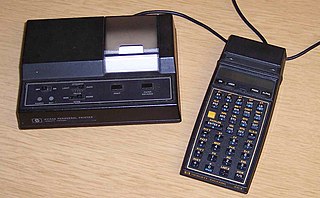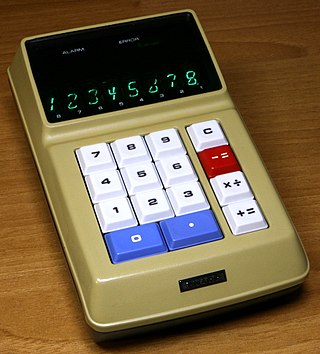
ASCII, an acronym for American Standard Code for Information Interchange, is a character encoding standard for electronic communication. ASCII codes represent text in computers, telecommunications equipment, and other devices. Because of technical limitations of computer systems at the time it was invented, ASCII has just 128 code points, of which only 95 are printable characters, which severely limited its scope. Modern computer systems have evolved to use Unicode, which has millions of code points, but the first 128 of these are the same as the ASCII set.

An electronic calculator is typically a portable electronic device used to perform calculations, ranging from basic arithmetic to complex mathematics.
In mathematics and computing, the hexadecimal numeral system is a positional numeral system that represents numbers using a radix (base) of sixteen. Unlike the decimal system representing numbers using ten symbols, hexadecimal uses sixteen distinct symbols, most often the symbols "0"–"9" to represent values 0 to 9, and "A"–"F" to represent values from ten to fifteen.

A liquid-crystal display (LCD) is a flat-panel display or other electronically modulated optical device that uses the light-modulating properties of liquid crystals combined with polarizers. Liquid crystals do not emit light directly but instead use a backlight or reflector to produce images in color or monochrome.
In computer science, extended Backus–Naur form (EBNF) is a family of metasyntax notations, any of which can be used to express a context-free grammar. EBNF is used to make a formal description of a formal language such as a computer programming language. They are extensions of the basic Backus–Naur form (BNF) metasyntax notation.
Although people in many parts of the world share common alphabets and numeral systems, styles of handwritten letterforms vary between individuals, and sometimes also vary systematically between regions.

The tab keyTab ↹ on a keyboard is used to advance the cursor to the next tab stop.

A seven-segment display is a form of electronic display device for displaying decimal numerals that is an alternative to the more complex dot matrix displays.

The HP-41C series are programmable, expandable, continuous memory handheld RPN calculators made by Hewlett-Packard from 1979 to 1990. The original model, HP-41C, was the first of its kind to offer alphanumeric display capabilities. Later came the HP-41CV and HP-41CX, offering more memory and functionality.
The vertical bar, |, is a glyph with various uses in mathematics, computing, and typography. It has many names, often related to particular meanings: Sheffer stroke, pipe, bar, or, vbar, and others.
A fourteen-segment display (FSD) is a type of display based on 14 segments that can be turned on or off to produce letters and numerals. It is an expansion of the more common seven-segment display, having an additional four diagonal and two vertical segments with the middle horizontal segment broken in half. A seven-segment display suffices for numerals and certain letters, but unambiguously rendering the ISO basic Latin alphabet requires more detail. A slight variation is the sixteen-segment display which allows additional legibility in displaying letters or other symbols.

A sixteen-segment display (SISD) is a type of display based on sixteen segments that can be turned on or off to produce a graphic pattern. It is an extension of the more common seven-segment display, adding four diagonal and two vertical segments and splitting the three horizontal segments in half. Other variants include the fourteen-segment display which does not split the top or bottom horizontal segments, and the twenty-two-segment display that allows lower-case characters with descenders.

Vehicles registered in Slovakia were generally assigned to one of the districts (okres) and from 1997 until 2022, the license plate coding generally consisted of seven characters and takes the form XX-NNNLL, where XX was a two letter code corresponding to the district, NNN was a three digit number and LL were two additional letters.
A stem-and-leaf display or stem-and-leaf plot is a device for presenting quantitative data in a graphical format, similar to a histogram, to assist in visualizing the shape of a distribution. They evolved from Arthur Bowley's work in the early 1900s, and are useful tools in exploratory data analysis. Stemplots became more commonly used in the 1980s after the publication of John Tukey's book on exploratory data analysis in 1977. The popularity during those years is attributable to their use of monospaced (typewriter) typestyles that allowed computer technology of the time to easily produce the graphics. Modern computers' superior graphic capabilities have meant these techniques are less often used.

The Sharp EL-8, also known as the ELSI-8, was one of the earliest mass-produced hand-held electronic calculators and the first hand-held calculator to be made by Sharp. Introduced around the start of 1971, it was based on Sharp's preceding QT-8D and QT-8B compact desktop calculators and used the same logic circuits, but it was redesigned to fit in a much smaller case.
A nine-segment display is a type of display based on nine segments that can be turned on or off according to the graphic pattern to be produced. It is an extension of the more common seven-segment display, having an additional two diagonal or vertical segments. It provides an efficient method of displaying alphanumeric characters.

The various shapes of numerical digits, letters, and punctuation on seven-segment displays is not standardized by any relevant entity. Unicode provides encoding codepoint for segmented digits in Unicode 13.0 in Symbols for Legacy Computing block.
Transformations of text are strategies to perform geometric transformations on text, particularly in systems that do not natively support transformation, such as HTML, seven-segment displays and plain text.
The modern numerical digit 0 is usually written as a circle, an ellipse or a rounded square or rectangle.

The Sharp QT-8D Micro Compet, a small electronic desktop calculator, was the first mass-produced calculator to have its logic circuitry entirely implemented with LSI integrated circuits (ICs) based on MOS (metal-oxide-semiconductor) technology. When it was introduced in late 1969, it was one of the smallest electronic calculators ever produced commercially. Previous electronic calculators had been about the size of a typewriter and had logic circuits built from numerous discrete transistors and diodes or small- to medium-scale ICs. The QT-8D's logic circuits were packed into just four LSI ICs.














